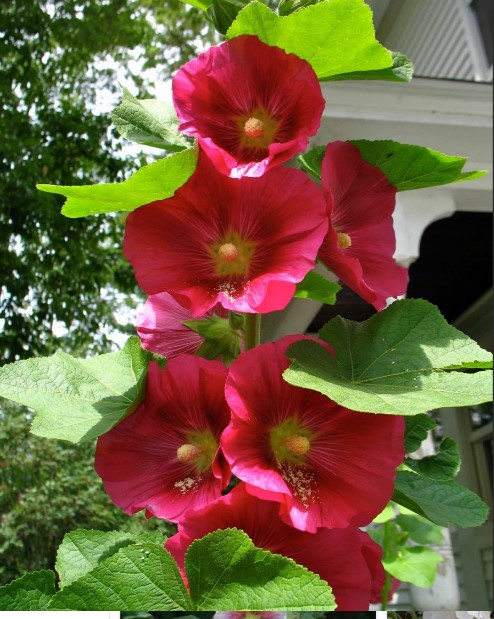How to Grow Hollyhocks: The Compete Hollyhock Flower Guide
Author Mare-Anne-Jarvela
Growing, Planting and Caring for Hollyhock Flowers
Have you spotted the hollyhocks blooming? Old-time favorites in cottage gardens, hollyhocks have multiple large blooms that grow on single tall stem! They are long blooming from June through August. Our Hollyhock Growing Guide provides information on planting, growing, harvesting, and even eating these showstopping flowers.
About Hollyhocks
Most of the old-fashioned types (Alcea rosea) are biennial: They produce foliage in the first year, then flower and self-seed before dying in the second. Once established, the plants perform like perennials, setting seed year after year. Due to their self-seeding properties, they may appear to spread, but, in actuality, they do not spread at all. Some newer varieties are considered perennial—they will bloom the first year and return year after year.
Hollyhocks grow 3 to 8 feet tall on a single stem, with single or double flowers that bloom from the bottom up. Butterflies, bees, and hummingbirds love these colorful blooms. Although hollyhocks originated in Asia, lore suggests their name may have originated during the “holy” religious Crusades (1095–1291), when anti-inflammatory salve from the plants was used to heal horses’ legs or hocks. In addition to their medicinal properties, hollyhocks are safe for human consumption and are not poisonous to dogs.
Planting
Hollyhocks prefer a sunny garden bed with full sun; they’ll manage in partial shade though they should get at least 6 hours of sun. The more sunlight, the more flowering! Generally speaking, hollyhocks will not thrive in the shade.
The plants are not fussy about soil, but they produce the best results in rich, well-draining, but moisture-retaining soil. Mix in compost, aged manure, or leaf mold prior to planting, and select a location that is sheltered from the wind.
When to Plant Hollyhocks
If you plan to sow the seeds outside, they can be planted in the early spring (after the last frost) or two months before the first fall frost. When starting the seeds indoors, they should be planted 8 to 10 weeks before your last spring frost date. Find your frost dates here.
How to Plant Hollyhocks
Sow groups of two or three seeds 2 to 3 feet apart, depending on fully grown plants’ size at maturity, in early spring after the last frost or beginning in August until 2
- months before the first fall frost.
- Press seeds into the soil and cover lightly with soil; sunlight aids in germination. Or, start seeds indoors 8 to 10 weeks before the last spring frost. (Sprouts emerge in 10 to 14 days.) Transplant outdoors when they are a few inches high.
- When transplanting seedlings or mature potted plants, minimize disturbance to the roots.
- For a stunning display, plant in groups of 8 to 12 plants along a fence or wall (in which case, staking is seldom needed).
- Water well.
Growing
Hollyhocks require little attention during the growing season, but a little attention goes a long way. Fertilize the flowers one or two times in a season with a 10-10-10 or soluble fertilizer. In order to keep the flowers standing tall, stake the plant, if they are not grown against a backing (such as a fence or a wall). Soak the soil around the plants regularly to ensure that they are receiving enough water to thrive.
As the hollyhocks bloom, you will want to remove the faded flowers to encourage more buds to open. If you are collecting seeds, after petals fall, look for brown seedpods that contain flat, blackish seeds that you can replant.
Caring for Hollyhocks in the Fall
At the end of the season, you will want to cut the plants to the ground. Clean up and discard all plant debris in the fall to minimize or avoid rust or remove infected plants completely and start new ones in a different location.
Types
All hollyhocks are beautiful and make a stunning addition to your garden, here are some of our favorite varieties:
- Alcea rosea ‘Radiant Rose’: large, pink, single flowers in the first year when started early;
5 to 6 feet tall; a true perennial; hardy to Zone 3. - Summer Carnival series: showy, long-lasting, double flowers in the first year from seed; pink, red, yellow, or white; 4 to 5 feet tall.
- ‘Powder Puffs’ mix: dense, 3- to 4-inch double flowers in shades of pink, red, white, yellow, and purple; 6 to 8 feet tall; hardy; reseeds vigorously.
- ‘Spring Celebrities’, ‘Queeny’, ‘Majorette’ mixes: double blooms in bright colors; about 3 feet tall; perfect for smaller gardens or containers.
Harvesting
Hollyhocks spires are breathtaking additions to your floral arrangements! Cut the stems for arrangements when one-third of the florets are open. Vase life is 7 to 10 days, you can remove the faded flowers to allow the buds higher on the stem to open.
Try adding hollyhocks to a bouquet with bellflowers, phlox, baby’s breath, and roses.
Wit and Wisdom
- Dahlias were often grown in front of hollyhocks to hide their “shins.”
- Sometimes used to hide outhouses, hollyhocks were called “outhouse flowers.”
- All parts of the hollyhock are edible; use petals in a salad or as a garnish. Here are 15 more edible flowers you can grow.
- Hollyhocks are in the mallow (Malvaceae) family and cousins of okra, cotton, and hibiscus.
Pests/Diseases
Hollyhocks tend to be quite resistant to pests and diseases, but there are a few that you should be on the lookout for.
Diseases: anthracnose, southern blight, fungal leaf spot, and rust.
Pests: Japanese beetles, leafhoppers, root-knot nematodes, and spider mites.
You may have noticed deer are not included on this list! Typically, deer avoid hollyhocks and choose to snack elsewhere.
Warmest Regards,
Coyalita Linville
Copyright © 2023 – 2024 Sunrise-Sunset-Nature-Gardens.com. All Rights Reserved Privacy Policy – Earning Disclaimer – Terms of Use – Contact Us

